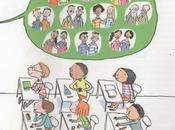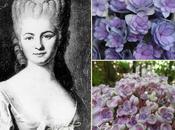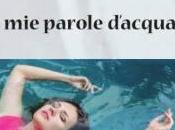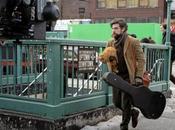
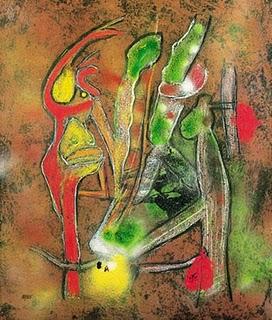

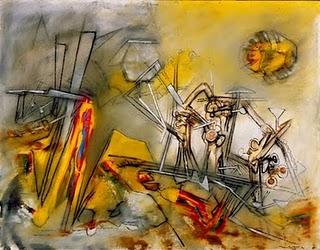
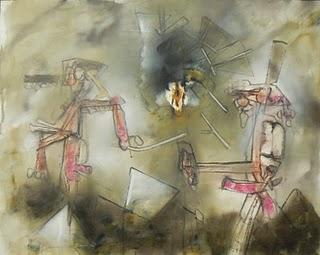
Roberto Antonio Sebastián Matta Echaurren, noto come Roberto Matta o Sebastian Matta, nasce a Santiago del Cile nel 1911. Dopo gli studi in architettura, nel 1934 si trasferisce a Parigi dove lavora con Le Corbusier ed entra in contatto con intellettuali come Rafael Alberti e Federico García Lorca. Conosce André Breton e Salvador Dalí e aderisce al Surrealismo elaborando una pittura incentrata su morfologie psicologiche.
È costantemente in movimento, dalla Scandinavia dove conosce Alvar Aalto a Londra per Henry Moore, Roland Penrose e René Magritte.
Su richiesta di Salvador Dalí va a trovare André Breton che lo dichiara surrealista. Di lui, nel 1944, André breton scrive: «Matta è colui che maggiormente tien fede alla propria stella, che è forse sulla strada migliore per arrivare al segreto supremo: il controllo del fuoco».
All'inizio della Seconda guerra mondiale fugge a New York assieme a molti altri artisti d'avanguardia. Qui esercita una decisiva influenza su alcuni giovani artisti come Jackson Pollock e Arshile Gorky. Viene allontanato dal gruppo surrealista (in cui successivamente fu riammesso), accusato di aver indirettamente provocato il suicidio di Gorky a causa della sua relazione con la moglie dell'amico pittore armeno.
Trasferitosi a Roma nel 1949 diventerà un importante punto di raccordo tra l'espressionismo astratto e il nascente astrattismo italiano.
Lasciata Roma nel 1954, si trasferisce a Parigi, mantenendo uno stretto legame con l'Italia. Dagli anni Sessanta elegge Tarquinia come sua residenza parallela stabilendosi in un ex convento dei frati Passionisti, dove è tuttora tumulato.
Tra il 1974 e il 1976 progetta e costruisce, con il pittore e scultore Bruno Elisei, l'Autoapocalipse, una casa edificata riciclando vecchie automobili, come provocazione contro il consumismo. I primi due moduli vengono esposti per la prima volta a Tarquinia (Chiesa di S. Maria in Castello) ed a Napoli (Campi Flegrei), poi ultimata (tre moduli) viene esposta a Bologna Galleria d'arte moderna), Terni (piazza del Comune), La Spezia (centro Allende), Firenze (rampe di San Niccolò-Forte Belvedere).
Nel 1985 il Centre Georges Pompidou di Parigi gli dedica una grande retrospettiva.
Matta muore a Civitavecchia il 23 novembre 2002.
Le sue opere sono esposte nei più importanti musei del mondo (Londra, New York, Venezia, Chicago, Roma, Washington, Parigi, Tokyo).
È il padre di Pablo Echaurren.
Born in Santiago on 1911, Roberto Antonio Sebastián Matta Echaurren, better known as Roberto Matta, initially studied architecture at the Pontificia Universidad Católica de Chile in Santiago, but became disillusioned with this occupation and left for Paris in 1933. His travels led him to meet artists such as René Magritte, Salvador Dalí, André Breton, and Le Corbusier. Matta was of Spanish, Basque and French descent.
It was Breton who provided the major spur to the Chilean's direction in art, encouraging his work and introducing him to the leading members of the Paris Surrealist movement. Matta produced illustrations and articles for Surrealist journals such as Minotaure. During this period he was introduced to the work of many prominent contemporary European artists, such as Pablo Picasso and Marcel Duchamp.
The first true flowering of Matta's own art came in 1938, when he moved from drawing to the oil painting for which he is best known. This period coincided with his emigration to the United States, where he lived until 1948. His early paintings, such as Invasion of the Night, give an indication of the work he would continue, with diffuse light patterns and bold lines on a featureless background. This is also the period of the "inscape" series, and the closely related "psychological morphologies". Prof. Claude Cernuschi writes, "Matta's key ambition to represent and evoke the human psyche in visual form was filtered through the writings of Freud and the psychoanalytic view of the mind as a three-dimensional space: the 'inscape'." According to the essay on Matta in Crosscurrents of Modernism, the inscapes' evocative forms "are visual analogies for the artist's psyche". During the 1940s and 1950s, the disturbing state of world politics found reflection in Matta's work, with the canvases becoming busy with images of electrical machinery and distressed figures. The addition of clay to Matta's paintings in the early 1960s lent an added dimension to the distortions.
In his art Matta creates new dimensions in a blend of organic and cosmic lifeforms. He was one of the first artists to take this abstract leap.
Matta's connections with Breton's surrealist movement were severed when a private disagreement led to his expulsion from the group, but by this time his own name was becoming widely known. He divided his life between Europe and South America during the 1950s and 1960s, successfully combining the political and the semi-abstract in epic surreal canvases. Matta believed that art and poetry can change the lives of people, and was very involved in the social movements of the 1960s and 1970s. He was a strong supporter of the socialist government of president Salvador Allende in Chile. A 4x24 meter mural of his entitled The First Goal of the Chilean People, was painted over with 16 coats of paint by the military regime of Augusto Pinochet following their violent overthrow of Salvador Allende in 1973. In 2005 the mural was discovered by local officials. In 2008 the mural was completely restored at a cost of $43,000, and is displayed today in Santiago at the La Granja city hall.
Throughout his life, Matta worked with many different types of media, including ceramic, photography, and video production.
Matta died in Civitavecchia, Italy on 23 November 2002. The Matta Estate is represented by The Pace Gallery, New York.
Matta is the father of the artist Pablo Echaurren.
